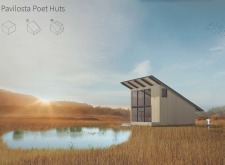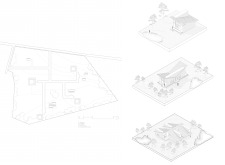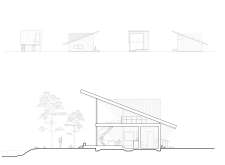5 key facts about this project
The structural design incorporates simple, geometric forms that prioritize functionality and aesthetic integration with the landscape. These huts consist of a cubic base with a sloped roof, allowing for efficient water drainage while presenting an appealing silhouette against the backdrop of the meadows and the nearby pond. Large glass facades create a seamless transition between the interior spaces and the external environment, facilitating natural light penetration and offering expansive views. This thoughtful use of transparency enhances the artistic atmosphere, encouraging inspiration and contemplation.
Design Approach and Materiality
A unique aspect of the Pavilosta Poet Huts project is the choice of materials, which underscores a commitment to sustainability. Locally sourced wood forms the core structure, providing both strength and warmth to the interiors. The implementation of metal roofing ensures durability and weather resistance, characteristics vital for a seaside location. Concrete serves as a stable foundation, carefully designed to minimize environmental impact while ensuring the integrity of the structure.
This project distinguishes itself through its harmonious blend of architecture and nature, fostering a tranquil environment. The spatial arrangements within the huts are intentional, allowing for versatile uses—ranging from personal writing spaces to communal gathering areas. Features such as a spiral staircase create visual interest and maximize vertical space, contributing to the overall functionality without compromising aesthetic appeal.
Spatial Layout and Community Focus
The spatial organization of the huts encourages interaction among residents while affording them individual privacy. The design positions the huts strategically on the site, enhancing each unit's orientation to the natural landscape. This layout not only enhances the occupants' experience but also promotes a sense of community among artists.
The Pavilosta Poet Huts aim to support creative processes through their architectural design, emphasizing open and flexible spaces conducive to artistic exploration. The integration of native landscaping within the site plan serves to enhance biodiversity, further complementing the project's goals of sustainability and aesthetic appreciation.
Readers interested in exploring the architectural details and design concepts are encouraged to examine the architectural plans and sections for a comprehensive understanding of this unique project. The architectural designs and ideas presented will offer insightful perspectives into the thoughtful relationship between art, architecture, and environment inherent in the Pavilosta Poet Huts.


























